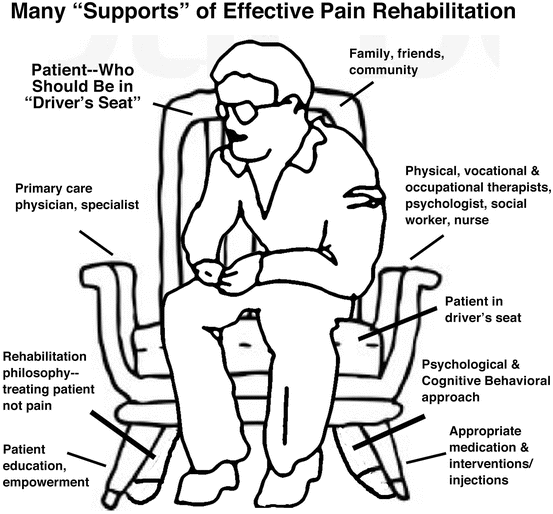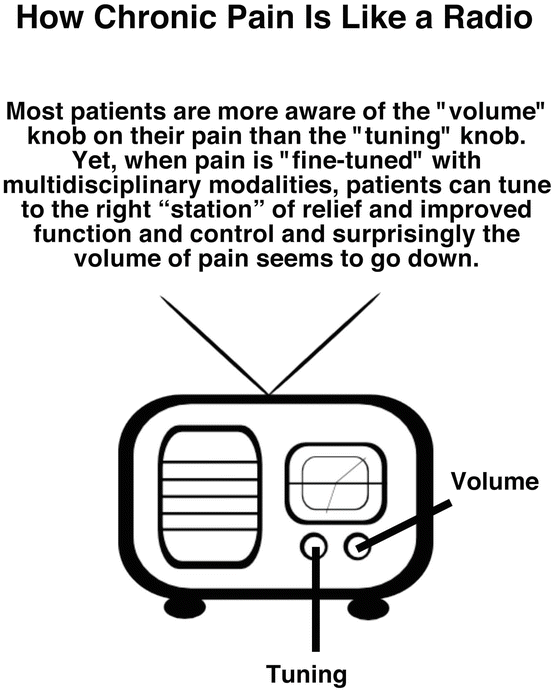(1)
Wisconsin Rehabilitation Medicine Professionals, Milwaukee, WI, USA
In this book, I will explain my personal philosophy of treating patients with chronic pain which is rooted in a multidisciplinary approach. We will also explore some popular treatments which are in wide use despite minimal evidence of their effectiveness. This book is written for clinicians—primary care physicians, physical and occupational therapists, psychologists, social workers, nurses, chiropractors and alternative healthcare providers—who see patients with chronic pain. As medical professionals, this book will help you understand the complexity of chronic pain and its treatment both which differ significantly from clinical treatment of acute pain both in practice and philosophy. It will help you guide your patients with appropriate care, education, and support to achieving and incorporating self-responsibility and self-efficacy in managing their own pain—the ultimate goal of multidisciplinary pain rehabilitation.
Academic medicine is often described as a three-legged stool balanced by one leg for teaching, patient care, and research. I like to think of pain rehabilitation as a four-legged chair with the two rear legs holding most of the weight. These strong back legs represent the behavioral/psychosocial and rehabilitation approach. The two front legs represent pharmacological and interventional/injection therapies, used as needed, and patient education/empowerment which is always needed. The seat and the rest of the chair represent the multidisciplinary team which provides a supportive environment for the individual to make the appropriate cognitive and behavioral changes and increase physical activities that are required for successful functioning despite the pain. The seat and rest of the chair, represents the patient who is surrounded with a weight-bearing system that make the chair stable (Fig. 1.1).


Fig. 1.1
Many “supports” of effective pain rehabilitation
Another useful image is the patient with chronic pain being like a radio with two knobs. The patient is very aware of the “volume” knob and less aware of the “tuning” knob, or maybe not aware of it at all. Yet, when chronic pain is “fine-tuned,” with the cafeteria of modalities offered by multidisciplinary care, the patient can tune to the right station of “relief” and improved function/control and surprisingly the volume of pain seems to go down as well, and certainly becomes easier to live with. The result is an increase in function with less dependence on the healthcare system and disability systems (Fig. 1.2).


Fig. 1.2
How chronic pain is like a radio
Many of the patients we see have had pain for months or years and repeatedly sought surgery, opioids and intervention treatments without effectiveness or positive outcomes. As more and more medical professionals have thrown up their hands at their patients with chronic pain conditions, these patients have lost hope and some have become despondent, depressed, and/or desperate.
In my years of practice I have had the opportunity to see and participate in the rehabilitation of more than 10,000 patients with chronic or persistent pain. Most of these patients have not responded to treatment with medications, surgery, anesthesia interventions, prescription drugs (mainly opioids/narcotics), chiropractic care and complementary and alternative medicine (CAM) techniques.
Most of these individuals have become dependent on medications even though they also usually say the medication is not helpful. They have become dependent on the healthcare system and continue to seek evaluations and treatment, hoping for the “fix” which only lead to despondency and failure. Constant pain has become a compelling force in their lives, incapacitating them from the roles they had once performed as workers, spouses, parents, and homemakers. Many have become full-time patients who think of themselves as disabled individuals. Yet these patients make astounding improvements when given a different “road” than the one they have been on: multidisciplinary pain rehabilitation.
Treating the Person Not the “Pain”
Chronic pain is a growing problem for patients and society as a whole. The many new books, scientific journals and government/medical task forces addressing chronic pain reveal the increase in growth and numbers of persons with chronic pain which frustrates patients and medical professionals alike. Despite medications, surgery and physical and anesthesiology interventions, the number of adults reporting chronic pain is increasing, as we explore in Chaps. 1 and 4. In this book, you will see how the very way chronic pain is currently regarded, as a purely biomedical experience to be treated with single, unimodal therapies instead of multidisciplinary, is behind the poor outcomes. There are only six ways to treat chronic pain, which we explore in Chap. 6: pharmaceuticals, interventions/injections done by anesthesiologists and other pain specialists, surgery, physical therapy modalities psychological approaches, and multidisciplinary rehabilitation. Significantly, a multidisciplinary approach is the only treatment that encompasses all of the other four modalities which explains its effectiveness.
There is no question that social, psychological, and environmental factors exert profound effects on chronic pain. These factors, which are often out of your patient’s awareness and control, are the reason unimodal interventions often fail and why multidisciplinary care is often remarkably successful: it addresses the vast web of factors that influence a patient’s pain from his emotional makeup and family life to his vocational and financial circumstances. This book will help you acquaint you and your patient with the many forces that affect his pain and adopt a new, positive attitude toward recovery.
Arguably, the most decisive factors in a chronic pain patient’s prognosis are his thoughts, beliefs, and attitudes—topics we address in depth in Chaps. 2, 3 and 4. The way a patient thinks will eventually shape his life narrative says the following quote, attributed to Gandhi, Lao Tzu, Ralph Waldo Emerson, and even Margaret Thatcher: “Your beliefs become your thoughts; Your thoughts become your words; Your words become your actions; Your actions become your habits; Your habits become your values; Your values become your destiny.”
“Your beliefs become your thoughts; Your thoughts become your words; Your words become your actions; Your actions become your habits; Your habits become your values; Your values become your destiny”
Most pain patients believe four “truisms” (see Table 1.1) about their pain which are not true at all for chronic pain (though they may be true for acute pain). As we treat, educate, and support patients in self-efficacy and self-management, we help them turn these misconceptions into a realistic view of their pain condition and how best to live with it.
Table 1.1



Patients’ chronic pain misconceptions/beliefs and realities

Full access? Get Clinical Tree





